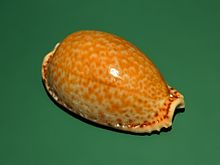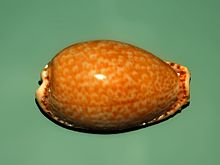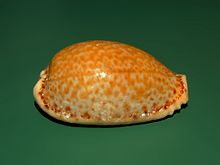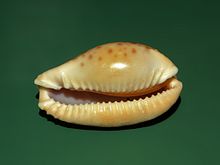- Erosaria spurca
-
Erosaria spurca A shell of Erosaria spurca a from Lampedusa Island, anterior end towards the right Scientific classification Kingdom: Animalia Phylum: Mollusca Class: Gastropoda (unranked): clade Caenogastropoda
clade Hypsogastropoda
clade LittorinimorphaSuperfamily: Cypraeoidea Family: Cypraeidae Genus: Erosaria Species: E. spurca Binomial name Erosaria spurca
(Linnaeus, 1758)Synonyms - Cypraea spurca (Linnaeus, 1758)
Erosaria spurca, common name the Dirty Cowry, is a species of sea snail, a cowry, a marine gastropod mollusk in the family Cypraeidae, the cowries.[1]
Contents
Description
The shells of these very common cowries reach on average 23–28 millimetres (0.91–1.1 in) of length, with a minimum size of 12 millimetres (0.47 in) and a maximum size of 39 millimetres (1.5 in). They are very variable in pattern and colour. The surface is smooth and shiny, the dorsum basic color is whitish or yellowish, with a variegated orange-brown, yellow ocher or reddish indistinct spotting on the dorsum. The yellowish margins are crenulated or bordered by a series of dimples. The base is whitish or cream, sometimes with shades of orange and some dark spots near the edge, while the teeth are usually large and white. In the living cowries the mantle is greyish, with quite long tree-shaped sensorial papillae.
Distribution
Erosaria spurca occurs in the central and southern Mediterranean Sea (southern Italy, Crete, Malta, Lampedusa Island, etc.), in the Red Sea (introduced) and in the eastern Atlantic Ocean along the West African coast (from Morocco to Angola, including Ascension Island, Canaries and Cape Verde Islands).
Habitat
These cowries commonly live at 2–20 metres (6 ft 7 in–65 ft 7 in) of depth, but they can also be found in deeper waters up to 50 metres (160 ft). During the day they are usually hidden under rocks, in crevices or in underwater meadows of Posidonia oceanica, as they start feeding at dusk.
Subspecies
- Erosaria spurca spurca (Linnaeus, 1758)
- Erosaria spurca verdensium Melvill, 1888
References
- ^ Erosaria spurca (Linnaeus, 1758). Gofas, S. (2009). Erosaria spurca (Linnaeus, 1758). In: Bouchet, P.; Gofas, S.; Rosenberg, G. World Marine Mollusca database. Accessed through the World Register of Marine Species at http://www.marinespecies.org/aphia.php?p=taxdetails&id=139497 on 5 June 2010.
- Repetto G., Orlando F. & Arduino G. (2005): Conchiglie del Mediterraneo, Amici del Museo "Federico Eusebio", Alba, Italy
- Prats Pi, L. (2002): Gastròpodes marins de la cala de Binissafúller, Menorca (Illes Balears)
External links
This Cypraeidae-related article is a stub. You can help Wikipedia by expanding it.




